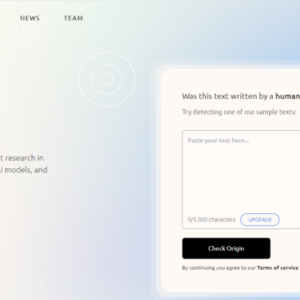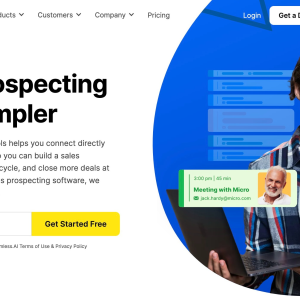ChatGPT, OpenAI’s state-of-the-art language model, has experienced a meteoric rise in popularity since its launch. This AI-powered chatbot has garnered attention from both the tech industry and the general public, thanks to its remarkable ability to generate human-like responses. As more and more people interact with ChatGPT, researchers and developers have been able to gather valuable insights into its growth and impact. In this article, we will delve into eight powerful findings that shed light on the incredible journey and potential of ChatGPT. From its impressive language capabilities to its role in aiding human productivity, these findings offer a glimpse into the immense possibilities that ChatGPT brings to the table.
- Generative Engine Optimization (GEO): The Future of SEO
- The Rise of Therapy Bots: How AI Is Transforming Mental Health Support
- AI in Business: How We Use Artificial Intelligence at Our Agencies
- 9 Top Copywriting Generators to Help Scale Your Sales Copy
- ChatGPT for Lawyers: How Can This AI Tool Help Improve Your Effectiveness?
Welcome to my blog on ChatGPT growth!
You are viewing: ChatGPT Growth: 8 Powerful Findings From Its Meteoric Rise
Imagine unlocking the secret to exponential growth for your business, reaching millions of users in record time, and scaling your platform beyond your wildest dreams.
What if I told you that ChatGPT, a seemingly unassuming chatbot, achieved all this and more?
In this blog, we’ll dissect the meteoric rise of ChatGPT, uncovering the strategies that propelled it to the forefront of the AI world.
1. Break Boundaries by Embracing the Familiar (with a Twist)

Innovation is often seen as the key to growth, but what happens when technology takes the world by storm, despite not being completely new?
Enter ChatGPT, a chatbot that began as a modest tool for providing straightforward information. Since its birth, it transformed into a highly advanced product capable of answering intricate questions and offering personalized suggestions.
Interestingly, Yann LeCun, Meta’s AI Chief, took to Twitter to emphasize that ChatGPT isn’t as groundbreaking as the public and media perceive it to be.
He tweeted, “To be clear: I’m not criticizing OpenAI’s work nor their claims. I’m trying to correct a perception by the public & the media who see chatGPT as this incredibly new, innovative, & unique technological breakthrough that is far ahead of everyone else. It’s just not.”
The creators initially presented ChatGPT as a mere “sneak peek” into their research, aiming to refine it through valuable public feedback. But, little did they know, it would soon become a sensation.
So, what’s the catch? And how did a two-year-old technology captivate the world?
For the first time, a highly capable linguistic superbrain is available to the general public through a free, easy-to-use web interface. This level of power in the hands of everyday users has never been experienced before.
Meanwhile, ChatGPT’s creators are still trying to decode its widespread appeal.
“We’re eager to unravel the mystery behind its success. But, honestly, it’s something we can’t quite comprehend yet,” confesses Liam Fedus, an OpenAI scientist who contributed to ChatGPT’s development.
The key takeaway here is that even though the technology itself may not be entirely novel, ChatGPT has brought a disruptive advancement to the table (even in the world of trading and investing).
By democratizing access to AI, it’s managed to capture the attention of millions. The future is here, folks!
2. The Power of Iterative Growth

ChatGPT’s journey to becoming a game-changing AI tool can be traced back to its creators’ unwavering dedication to iterative growth, embracing imperfection, and valuing user feedback.
ChatGPT’s Timeline
Let’s take a stroll down memory lane, highlighting the key releases that shaped ChatGPT’s evolution:
- 2018: GPT-1 burst onto the scene, wowing users with its ability to generate human-like text and handle a range of tasks, from translation to summarization.
- June 2019: GPT-2 upped the ante, boasting a larger dataset, more parameters, and improved coherence, paving the way for diverse applications.
- June 2020: GPT-3 took language understanding to new heights, introducing multi-modal capabilities and laying the foundation for innovative tools like DALL-E-2 and ChatGPT.
- January 2021: DALL-E-2 transformed image generation, breathing life into captivating, imaginative visuals from mere text descriptions.
- November 2022: ChatGPT, a conversational AI built on GPT-3, remembered past interactions and made GPT -3’s power accessible to a wider audience.
- March 2023: Open AI releases ChatGPT API, which allows developers to integrate the tech into their apps.
- March 2023: GPT-4 shatters expectations, leveraging a colossal dataset and delivering unprecedented capabilities.
Open AI Embraces Imperfection
This growth mindset allowed ChatGPT to rapidly adapt to user needs, ensuring a dynamic, ever-evolving platform. In addition, OpenAI kept users engaged and excited about new possibilities by continuously seeking user feedback and rolling out updates.
OpenAI’s blog emphasizes the importance of user feedback in driving innovation, stating, “We know that many limitations remain [with ChatGPT], and we plan to make regular model updates… But we also hope that by providing an accessible interface to ChatGPT, we will get valuable user feedback.”
Moreover, this iterative approach enabled swift experimentation, allowing OpenAI to discover what resonated with users without investing excessive time and resources.
As a testament to this strategy, millions of people have provided feedback, leading to several important updates.
In addition, users have found value across various professional use cases, such as:
- Drafting and editing content
- Brainstorming ideas
- Programming help
- And learning new topics.
ChatGPT’s triumph reflects OpenAI’s boldness to launch products before perfection.
Open AI researcher John Schulman reinforces this idea:
See more : How to Get Google Bard to Do Your Marketing for You
“You can’t wait until your system is perfect to release it… the beta testers had positive impressions of the product.”
Ultimately, by embracing imperfection and focusing on delivering value, OpenAI has continuously refined and enhanced ChatGPT, turning it into the powerhouse tool it is today.
3. Build a Versatile and Adaptable Idea

The success of ChatGPT is rooted in its incredible versatility.
It’s a cinch to use. It’s downright captivating in its ability to rapidly whip up human-like text, whether you’re craving recipes, workout plans, or—here’s the kicker—computer code. (Read more about the cool and creative uses of ChatGPT.)
One way ChatGPT demonstrates versatility is by acting as a personal assistant. It’s like a reliable friend who organizes emails, sets reminders, and drafts responses on their behalf.
With ChatGPT as their AI sidekick, users can breathe a sigh of relief and focus on more pressing tasks. (Read more about ChatGPT for productivity and efficiency.)
In the realm of healthcare, ChatGPT’s versatility opens up exciting possibilities. Bill Gates underscored how AI will revolutionize the medical field by processing complex data and accelerating drug development.
ChatGPT has the potential to become an invaluable tool that enhances doctor-patient communication and even offers personalized health advice. The implications are truly remarkable.
And get this:
Surprisingly, ChatGPT reportedly outperforms human doctors in empathy and quality of medical advice, according to a recent study.
ChatGPT’s versatility also extends to education, where it can be a transformative force. Picture a world where every student can access their own AI tutor, providing customized lessons and real-time feedback.
Say goodbye to the era of elite tutoring monopolies! With the assistance of ChatGPT, education can become more democratized for learners across the globe.
4. Prioritize User Friendliness and Accessibility

A key ingredient in ChatGPT’s recipe for success lies in its remarkably user-friendly interface.
The platform’s design ensures that even users new to chatbots or artificial intelligence technology can easily find their way around. This welcoming simplicity has been a major draw for users from all walks of life.
As OpenAI scientist Liam Fedus explains, the addition of conversational data truly set ChatGPT apart:
“The ChatGPT model is fine-tuned from the same language model as InstructGPT, and we used a similar methodology for fine-tuning it. We added some conversational data and tuned the training process a bit. So we didn’t want to oversell it as a big fundamental advance. As it turned out, the conversational data had a big positive impact on ChatGPT.”
This subtle yet significant change transformed ChatGPT from a mere AI chatbot into a virtual companion on which users could rely for accurate and personalized information.
ChatGPT’s personable nature and the AI’s clear and concise responses provide an immersive experience. It’s as if users are having a genuine conversation with a knowledgeable friend rather than interacting with an AI.
John Schulman, a researcher at OpenAI, highlights the importance of accessibility and usability, saying, “The raw technical capabilities, as assessed by standard benchmarks, don’t actually differ substantially between the models, but ChatGPT is more accessible and usable.”
Moreover, ChatGPT’s design philosophy prioritizes functionality over flashy aesthetics. The website sports a clean, minimalistic look, which keeps users focused on the task at hand: their interactions with the chatbot.
5. Identify and Fill Underserved Needs

But what truly sets ChatGPT apart is its ability to add value where search engines fall short.
Unlike search engines, which rely on users to input specific keywords or phrases, ChatGPT engages users in a dynamic conversation that allows for personalized exploration of topics.
This interactive approach saves time by eliminating the need to sift through numerous websites and provides users with a more comprehensive understanding of the subject matter (as long as the information is accurate).
Additionally, ChatGPT has a remarkable capacity for contextual understanding, which enables it to recognize nuances in users’ questions and tailor responses accordingly.
Another distinctive feature of ChatGPT is its ability to synthesize information from various sources. This offers users a well-rounded perspective on any given topic.
This is a stark contrast to search engines, which often serve up information based on popularity or keyword optimization, potentially leaving out valuable insights.
6. Balance Free Access with Enticing Premium Features

Unlocking rapid user base expansion is challenging, but ChatGPT managed to crack the code by blending free access with enticing premium features.
Their strategic combination of accessibility and value-added offerings was crucial in achieving 100 million users in just two months.
See more : Reasons Why AI Is Overrated for Marketers in 2023
Just think: It took the viral sensation TikTok 9 months, Instagram 2 years, and Google and Facebook 5 years to hit the same mark.
Picture the excitement as ChatGPT hits the market, offering users free access to its groundbreaking AI capabilities.
This opportunity to experience cutting-edge technology without commitment lures users from all walks of life. But the thrill doesn’t end there – for those who crave even more from their AI chatbot experience, ChatGPT’s premium offerings hold the key.
With lightning-fast response times, priority access to new features and improvements, and uninterrupted functionality during peak hours, upgrading your account becomes attractive.
As a premium user myself, I can speak directly to this. I was drawn to the allure of GPT-4’s impressive capabilities and the opportunity to skirt outages during high-demand periods. So the decision to upgrade was a no-brainer.
This expert fusion of free access and premium benefits creates the ultimate growth hacking recipe.
So, how does ChatGPT strike this delicate balance? By ensuring that the free version offers enough value to retain user interest while still providing a clear incentive to upgrade.
7. Leverage API Integration for Scalability

The release of the ChatGPT API is set to propel the platform to massive adoption.
As we delve into the mechanics of this growth and reveal the far-reaching consequences for developers, businesses, and users, we’ll uncover lessons for any platform looking to scale up.
The first key aspect is wider integration. Picture developers weaving the AI-powered chatbot into an array of applications, tools, and platforms. As ChatGPT’s reach expands, it will create ripples of impact across numerous industries.
Customization is another vital ingredient. The API enables developers to mold the ChatGPT experience to meet their specific needs, making the platform even more attractive. This tailored approach reels new users and sparks innovative use cases that we might not have imagined before.
As the saying goes, “Two heads are better than one.” The ChatGPT API embraces this by promoting collaboration. By connecting developers with the OpenAI community, we see a meeting of minds that elevates the technology to new heights.
New business opportunities are also unlocked as developers integrate the ChatGPT API into their products and services. As this happens, organizations will begin to recognize the potential for increased efficiency, cost savings, and improved customer experiences, igniting a surge in growth.
Lastly, there’s the feedback loop. With the API’s widespread use, OpenAI will harvest valuable insights from the community, allowing the platform to evolve based on real-world needs. It’s like a virtuous cycle of growth fueled by the collective wisdom of its users.
8. Uphold Privacy and Security Standards

In today’s digital landscape, privacy and security are the building blocks of a platform’s success. Without them, regulatory hurdles and diminishing user trust can hamstring growth.
GDPR (General Data Protection Regulation) is a prime example of holding companies accountable for handling user data.
Consider the cautionary tale of Facebook. The social media giant weathered storm after storm of privacy scandals. These privacy slip-ups have hit the brakes on user growth, eroded trust, and thrown a wrench in their expansion plans.
At its core, ChatGPT is designed to generate human-like text based on the input. However, this capability also raises questions about how user data is handled, stored, and protected.
Concerns Over Privacy in Italy
We’re already seeing privacy speedbumps for ChatGPT.
The Italian Data Protection Authority (DPA) expressed concerns over ChatGPT’s compliance with GDPR, particularly regarding the potential misuse of personal data.
Italian authorities feared that ChatGPT’s AI capabilities might inadvertently expose sensitive user information, so they banned ChatGPT.
In response to these concerns, OpenAI addressed the Italian DPA’s apprehensions:
- OpenAI now offers a tool to verify users’ ages in Italy
- They commit to providing greater visibility of privacy policy
- Open AI now offers EU users a new form to object to the use of personal data
Italy lifted the ban after OpenAI worked with the DPA to ensure compliance with data protection regulations.
You can read more about how you can manage your data with ChatGPT here.
As ChatGPT expands, OpenAI must remain proactive in addressing privacy concerns, ensuring that users feel secure while enjoying the benefits of this cutting-edge AI tool.
ChatGPT Growth – Final Thoughts
Now that you’re armed with these powerful insights, the challenge is clear: How will you apply these principles to your own ventures, and what heights will you achieve? The future is yours to shape.
That concludes the article: ChatGPT Growth: 8 Powerful Findings From Its Meteoric Rise
I hope this article has provided you with valuable knowledge. If you find it useful, feel free to leave a comment and recommend our website!
Click here to read other interesting articles: AI
Source: guidelisters.com
#ChatGPT #Growth #Powerful #Findings #Meteoric #Rise
Source: https://guidelisters.com
Category: AI





